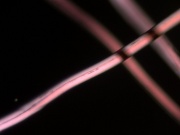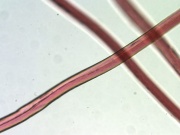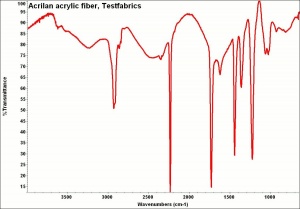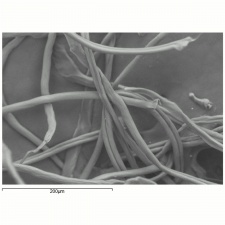Difference between revisions of "Acrilan"
Jump to navigation
Jump to search
| Line 1: | Line 1: | ||
[[File:69 Acrilan16 200X pol.jpg|thumb|Acrilan®]] | [[File:69 Acrilan16 200X pol.jpg|thumb|Acrilan®]] | ||
| + | [[File:69 Acrilan16 200X.jpg|thumb|Acrilan®]] | ||
== Description == | == Description == | ||
[Solutia, Inc.] A registered trademark for an acrylonitrile-vinyl acetate copolymer fiber that is commonly used in textiles. Acrilan® was first produced in 1949 by Chemstrand Corp. After slight changes in the formulation and manufacturing procedures, Acrilan® was commercially manufactured in 1954. It is an [[acrylic%20fiber|acrylic fiber]] copolymerized with less than 15% vinyl acetate groups. Acrilans are noted for softness, strength and wrinkle-resistant properties. Acrilan® is used for clothing, carpets, drapes, upholstery and laminates. | [Solutia, Inc.] A registered trademark for an acrylonitrile-vinyl acetate copolymer fiber that is commonly used in textiles. Acrilan® was first produced in 1949 by Chemstrand Corp. After slight changes in the formulation and manufacturing procedures, Acrilan® was commercially manufactured in 1954. It is an [[acrylic%20fiber|acrylic fiber]] copolymerized with less than 15% vinyl acetate groups. Acrilans are noted for softness, strength and wrinkle-resistant properties. Acrilan® is used for clothing, carpets, drapes, upholstery and laminates. | ||
| − | |||
[[[SliderGallery rightalign|AcrilanTestfabrics.jpg~FTIR|acrilan300m.jpg~SEM]]] | [[[SliderGallery rightalign|AcrilanTestfabrics.jpg~FTIR|acrilan300m.jpg~SEM]]] | ||
| Line 15: | Line 15: | ||
* Soluble in dimethyl sulfoxide, ethylene carbonate, and nitriles. | * Soluble in dimethyl sulfoxide, ethylene carbonate, and nitriles. | ||
* Insoluble in ethanol, acetone, benzene, carbon tetrachloride, and ligroin. | * Insoluble in ethanol, acetone, benzene, carbon tetrachloride, and ligroin. | ||
| − | |||
| − | |||
| − | |||
| − | |||
== Comparisons == | == Comparisons == | ||
Revision as of 09:07, 24 April 2022
Description
[Solutia, Inc.] A registered trademark for an acrylonitrile-vinyl acetate copolymer fiber that is commonly used in textiles. Acrilan® was first produced in 1949 by Chemstrand Corp. After slight changes in the formulation and manufacturing procedures, Acrilan® was commercially manufactured in 1954. It is an Acrylic fiber copolymerized with less than 15% vinyl acetate groups. Acrilans are noted for softness, strength and wrinkle-resistant properties. Acrilan® is used for clothing, carpets, drapes, upholstery and laminates.
Risks
Solutia MSDS
Physical and Chemical Properties
- Soluble in dimethyl sulfoxide, ethylene carbonate, and nitriles.
- Insoluble in ethanol, acetone, benzene, carbon tetrachloride, and ligroin.
Comparisons
Properties of Synthetic Fibers
Resources and Citations
- Solutia: Acrilan® fiber
- G.S.Brady, Materials Handbook, McGraw-Hill Book Co., New York, 1971
- Fairchild's Dictionary of Textiles, Phyllis G.Tortora, Robert S. Merkel (eds.), Fairchild Publications, New York City, 7th edition, 1996
- Rosalie Rosso King, Textile Identification, Conservation, and Preservation, Noyes Publications, Park Ridge, NJ, 1985
- Meredith Montague, contributed information, 1998
- Solutia Inc. (formerly Monsanto Fibers) Website: Link



